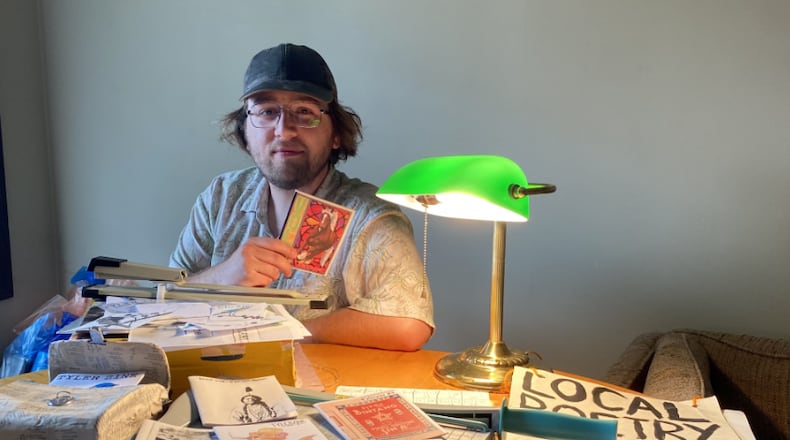A zine (short for magazine), by definition, is a small-circulation, self-published work of original text or images typically reproduced by a copy machine. In the case of “Tylerzine,” only 30 to 50 copies of each volume are printed — of which there are currently seven volumes, with an eighth in the works — though back issues are available as requested.
An older friend who was heavily involved in the graffiti skate-punk scene in the 1990s first introduced Lewis to zines. The friend showed Lewis a stack of zines he had collected and suggested he make one of his own. Lewis liked the idea of not having to answer to anyone, not having to wait around to have his work published elsewhere, to make his own publication.
Lewis published his first poetry zine, “Bronze Gears & The Soft Machine,” in March 2019. “Casualties of Circumstance,” the second volume, came out in November 2019. He ran out of cool titles by the third and went with the eponymous “Tylerzine” instead, leaning into brand recognition instead of the ephemerality of a name-alternating publication.
While local boutiques sometimes stock zines on counters, Lewis often sells “Tylerzine” while perusing art fairs, wearing a double-sided handmade sign that reads “Local Poetry Zine $5,” along with a facade of the current issue pasted to the front. He carries them in a vintage camera bag, plastered with pages of an outdated medical dictionary for no particular reason. On good days, he’ll sell eight to ten zines. On a bad day, one or two.
Each costs around 80 cents to produce, but that doesn’t take into consideration the 25 to 40 hours of layout, design and editing involved, or the time they take to sell. Lewis says he only wants to make enough money to produce the next issue.
“Tylerzine” might appear to be made with cheap 20 lbs. copy paper (because it is), halved and stapled into small booklets of amateur poetry, but it’s also easy to overlook the dedication it takes to make. After holding the product, one might think if money were no object Lewis would give the zines away for free, taking capitalism out of the picture altogether.
Despite what the name might suggest, the pages of “Tylerzine” are not just Tyler-centric; they are filled with local poets and short-story writers — mostly, but not exclusively, Lewis’ friends and fellow students — paid in complimentary copies and an outlet for artistic expression.
What’s included in each zine is at the discretion of the zine-maker, an autonomous editor unaffected by outside suggestions or at the behest of advertisers or bureaucracy. A zine is whatever it wants to be. It’s an anarchic, punk product only inhibited by the number of pages two staples can handle.
In the masthead of “Tylerzine,” underneath the submission guidelines — a feature that appeared after the “failed” volume four — it states that no material generated or inspired directly by AI should be submitted. AI is taboo in the eyes of “Tylerzine,” betraying the very idea zines promote: artifactuality over artificiality.
Zines have short runs, but there is a meticulous process to get them into a final form that may go unnoticed. Inside might just be negative space and poetry, but every cover of “Tylerzine” is made with a different art form, like collage, photography, penciling, marker, found object and block printing.
The techniques are too detailed to go into here, but they usually involve cutting and pasting the layout on a physical master copy, and only rarely involve the severing of neon fanny packs for the colors (see: volume six). Computers — save for the typing, copying and submission processes — remain virtually untouched.
“There’s a German word, fingerspitzengefühl, that means ‘fingertip feeling,’” Lewis typed in purple ink on a sheet of talking points. “That’s what I’m trying to bring to it with doing so much by hand. The process is labor-intensive but I wouldn’t want to make it more efficient at the price of further removing my spirit from the creation.”
Lewis believes that something handmade has a heavier existence, which might explain why he puts so much effort into each volume.
“All the work involved in the process feels completely worth it when I hear back from contributors… and they tell me they love how it came out,” Lewis said. “It means a lot to me that I can share people’s work in a way that they feel proud of.”
“Tylerzine” is just one example within this maverick literary subculture of self-publishing.
Fanzines, comic zines, music zines and zines of all topics permeate the art world. It’s where rogue writers, poets and philosophers can spread their ideas through flawed, invaluable, human, tangible and ephemeral means, like pre-blogs existing in a post-blogging world. Zines are for people, by people dedicated enough to make them.
Check your local counters.
For inquiries about purchasing back issues of “Tylerzine” and/or sending submissions, email Tyler Lewis at tylerzine@gmail.com.
About the Author

